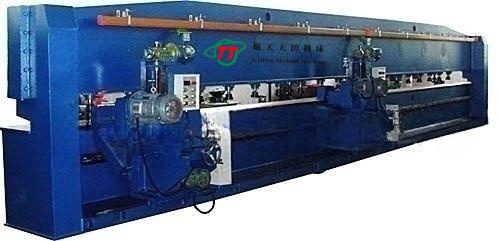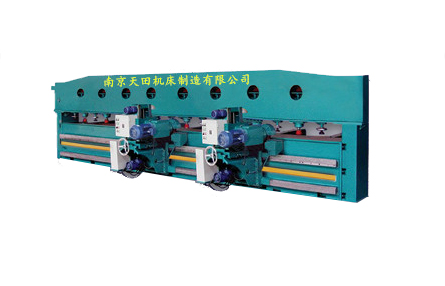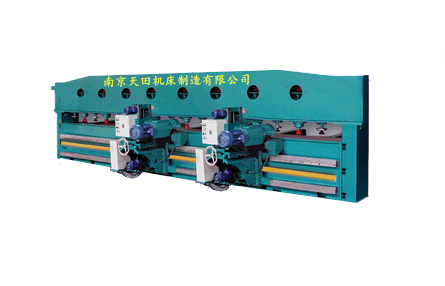

该铣边机导轨安装形式为可拆装式,并通过热处理,床身结构合理,铣削头运行更平稳可靠,其进给系统与返程系统完全独立,返程速度快、效率高、铣刀盘的角度调整方便,定制刀盘与标准刀盘可互换,是传统铣边机的更新换代产品。
本文详细阐述了双头有压梁铣边机的应用场地、具体作用以及性能特点。通过分析其在不同工业领域的应用场景,揭示了该设备在材料加工过程中的重要作用。同时,从设备结构、加工能力、操作便捷性等多个方面深入探讨其性能特点,为相关行业合理选用和高效使用双头有压梁铣边机提供全面参考。
双头有压梁铣边机;应用场地;作用;性能特点
在现代工业制造领域,材料边缘加工的质量和效率对产品的最终性能和生产周期有着重要影响。双头有压梁铣边机作为一种专业的边缘加工设备,凭借其独特的设计和强大的功能,在众多行业中得到广泛应用。深入了解该设备的应用场地、作用以及性能特点,有助于充分发挥其优势,提升工业生产的整体水平 。
在大型钢结构制造企业中,双头有压梁铣边机是不可或缺的加工设备。无论是桥梁建设、高层建筑的钢结构框架制作,还是大型厂房的钢架构建,都需要对大量的钢板、型钢进行边缘加工。例如,在桥梁钢梁的制造过程中,需要将钢板加工成符合设计要求的形状和尺寸,以便进行焊接组装。双头有压梁铣边机能够对钢板的边缘进行精确铣削,去除毛刺、氧化皮,加工出合适的焊接坡口,为后续焊接工序提供高质量的接口,保证钢结构的连接强度和稳定性 。
船舶的船体结构由大量的钢板焊接而成,对钢板边缘的加工精度和质量要求极高。双头有压梁铣边机可用于船舶板材的边缘处理,能够快速高效地铣削出各种形状的坡口,如 X 形、V 形、Y 形等,满足不同焊接工艺的需求。同时,在船舶内部结构件,如舱壁、甲板等的加工过程中,该设备也能发挥重要作用,确保各部件之间的连接紧密,提高船舶的整体强度和密封性 。
压力容器的制造对材料的加工精度和质量有着严格的标准。双头有压梁铣边机可对用于制造压力容器的钢板进行精确铣边,保证边缘的平整度和尺寸精度,加工出符合要求的焊接坡口。通过精确控制铣削参数,能够有效消除材料表面的缺陷,提高焊接质量,确保压力容器在使用过程中的安全性和可靠性 。
在各类机械加工车间中,对于一些形状复杂、精度要求较高的零部件,需要对其边缘进行精细加工。双头有压梁铣边机可以对机械零件的毛坯进行边缘修整,去除不规则部分,为后续的机械加工工序奠定基础。同时,在零件的焊接组装前,对其边缘进行铣削加工,能够提高零件之间的装配精度,保证机械产品的整体性能 。
去除材料边缘在切割、锻造等前期加工过程中产生的毛刺、毛边和不平整部分,使材料边缘更加光滑、整齐,为后续的加工和装配提供良好的基础。例如,对于火焰切割后的钢板,其边缘往往存在高低不平的熔渣和氧化皮,双头有压梁铣边机能够快速有效地将这些多余部分去除,使钢板边缘达到所需的平整度 。
根据不同的焊接工艺要求,加工出各种形状和角度的焊接坡口。合理的坡口设计能够增加焊接接头的强度,保证焊接质量,减少焊接变形。例如,在厚板焊接时,通过铣削出合适的坡口,可以使焊接材料更好地填充,形成牢固的焊接接头 。
确保材料边缘的尺寸精度,使加工后的材料符合设计图纸的要求。通过精确的定位和进给系统,双头有压梁铣边机能够将材料边缘的尺寸误差控制在极小的范围内,满足高精度加工的需求,提高产品的合格率 。
配备两个铣削头,可同时对材料的两端进行加工,相比单头铣边机,加工效率提高近一倍。在处理长尺寸材料时,无需进行二次装夹和定位,减少了辅助时间,大大提升了生产效率,尤其适用于大批量生产场景 。
独特的压梁设计能够在加工过程中对材料进行稳固压紧,防止材料在铣削力的作用下发生位移或振动。压梁的压力大小可根据材料的厚度和材质进行调节,确保不同规格的材料都能得到稳定可靠的加工,从而提高加工精度和表面质量 。
能够适应多种材料的加工,包括碳钢、不锈钢、合金钢等金属材料,以及部分非金属材料。设备配备大功率的铣削电机和优质的刀具,可承受较大的切削负荷,能够对较厚的板材和型钢进行高效铣削,满足不同行业对材料加工厚度和硬度的要求 。
采用先进的数控系统,可实现对铣削过程的精确控制。操作人员通过编程输入加工参数,如铣削深度、进给速度、坡口角度等,设备即可按照预设程序自动完成加工任务。数控系统还具备误差补偿功能,能够实时监测和调整加工过程中的误差,保证加工精度的稳定性 。
人机交互界面友好,操作简单易懂,操作人员经过短期培训即可熟练掌握设备的操作方法。设备的结构设计合理,各部件布局紧凑,便于日常的检查、维护和保养。刀具更换方便快捷,可有效减少停机时间,提高设备的利用率 。
设置了多种安全防护装置,如防护罩、急停按钮、过载保护等,能够有效防止操作人员受到意外伤害,保障设备的安全运行。同时,设备的关键部件采用优质材料制造,经过严格的质量检测和性能测试,具有较高的可靠性和稳定性,可长时间连续运行 。
双头有压梁铣边机凭借其广泛的应用场地、重要的加工作用以及显著的性能特点,在现代工业制造中发挥着不可替代的作用。随着工业技术的不断进步和各行业对产品质量要求的日益提高,双头有压梁铣边机也将不断进行技术创新和升级,以更好地满足市场需求。未来,该设备有望在智能化控制、加工精度提升、节能环保等方面取得更大的突破,为工业生产的高效、高质量发展提供更有力的支持。
铣削能力:
铣削宽度:指双刀头能够同时铣削的板材边缘宽度范围,例如可能在一定规格内可实现对不同宽度板材的边缘加工,常见的数值可能在几十毫米到几百毫米之间,具体取决于型号。
铣削厚度:表示该铣边机能够加工的板材厚度上限和下限,一般来说可以加工从较薄的板材到一定厚度的板材,如从 1 - 2 毫米的薄板到几十毫米甚至更厚的厚板,不同型号有所不同。
铣削速度:双刀头的旋转速度,通常以每分钟多少转(rpm)来衡量,较高的铣削速度可以提高加工效率,但也需要结合刀具和板材材质等因素进行调整,常见的速度范围可能在几百到数千转每分钟。
刀具参数:
刀具直径:所使用的铣刀直径大小,不同的刀具直径适用于不同的加工需求和板材厚度,常见的刀具直径可能在几十毫米到上百毫米之间。
刀具齿数:刀具上的切削刃数量,齿数的多少会影响切削的平稳性和加工表面质量,一般有 4 齿、6 齿、8 齿等不同选择。
刀具材质:通常采用硬质合金等耐磨、高强度材质,以保证刀具的使用寿命和切削性能。
压梁参数:
压梁压力:压梁对板材施加的压力大小,可根据板材的材质、厚度等进行调整,以确保板材在铣削过程中保持稳定,压力范围可能从几千牛到几万牛不等。
压梁行程:压梁能够上下移动的距离,以适应不同厚度的板材,一般行程在几十毫米到几百毫米之间。
压梁宽度:压梁与板材接触的宽度,足够的宽度可以提供更均匀的压力分布,保证板材在加工过程中的稳定性,常见的宽度可能在几十毫米左右。
进给参数:
电机功率:
精度参数:
This article elaborates on the application sites, specific functions, and performance characteristics of double-head press-beam edge milling machines. By analyzing their application scenarios in different industrial fields, it reveals the important role of this equipment in the material processing process. At the same time, it deeply explores its performance characteristics in terms of equipment structure, processing capacity, operation convenience, and other aspects, providing a comprehensive reference for relevant industries to reasonably select and efficiently use double-head press-beam edge milling machines.
Double-head press-beam edge milling machine; Application site; Function; Performance characteristics
In the modern industrial manufacturing field, the quality and efficiency of material edge processing have a significant impact on the final performance and production cycle of products. As a professional edge processing equipment, the double-head press-beam edge milling machine has been widely applied in many industries due to its unique design and powerful functions. In-depth understanding of the application sites, functions, and performance characteristics of this equipment helps to give full play to its advantages and improve the overall level of industrial production.
In large steel structure manufacturing enterprises, the double-head press-beam edge milling machine is an essential processing equipment. Whether it is the fabrication of steel structures for bridges, high-rise buildings, or the construction of steel frames for large workshops, a large number of steel plates and sections need to be processed at the edges. For example, during the manufacturing process of bridge girders, steel plates need to be processed into the required shapes and sizes for welding assembly. The double-head press-beam edge milling machine can precisely mill the edges of steel plates, remove burrs and oxide scales, and process appropriate welding grooves, providing high-quality interfaces for subsequent welding processes and ensuring the connection strength and stability of the steel structure.
The hull structure of ships is welded from a large number of steel plates, and extremely high precision and quality are required for the edge processing of the steel plates. The double-head press-beam edge milling machine can be used for the edge processing of ship plates. It can quickly and efficiently mill various shapes of grooves, such as X-shaped, V-shaped, and Y-shaped, meeting the requirements of different welding processes. At the same time, in the processing of internal structural components of ships, such as bulkheads and decks, this equipment can also play an important role, ensuring a tight connection between various components and improving the overall strength and sealing performance of the ship.
There are strict standards for the processing precision and quality of materials in the manufacturing of pressure vessels. The double-head press-beam edge milling machine can precisely mill the edges of steel plates used in the manufacturing of pressure vessels, ensuring the flatness and dimensional accuracy of the edges and processing the required welding grooves. By precisely controlling the milling parameters, it can effectively eliminate surface defects of the materials, improve the welding quality, and ensure the safety and reliability of the pressure vessel during use.
In various machining workshops, for some parts with complex shapes and high precision requirements, their edges need to be finely processed. The double-head press-beam edge milling machine can trim the edges of the blanks of mechanical parts, removing irregular parts and laying the foundation for subsequent machining processes. At the same time, before the welding and assembly of parts, milling the edges can improve the assembly accuracy between parts and ensure the overall performance of mechanical products.
Remove burrs, rough edges, and uneven parts generated during previous processing such as cutting and forging on the material edges, making the material edges smoother and neater, and providing a good foundation for subsequent processing and assembly. For example, for steel plates cut by flame cutting, there are often uneven slag and oxide scales on the edges. The double-head press-beam edge milling machine can quickly and effectively remove these excess parts, making the edges of the steel plates reach the required flatness.
Process various shapes and angles of welding grooves according to different welding process requirements. A reasonable groove design can increase the strength of the welding joint, ensure the welding quality, and reduce welding deformation. For example, when welding thick plates, by milling appropriate grooves, the welding materials can be better filled to form a firm welding joint.
Ensure the dimensional accuracy of the material edges, making the processed materials meet the requirements of the design drawings. Through the precise positioning and feeding system, the double-head press-beam edge milling machine can control the dimensional error of the material edges within a very small range, meeting the requirements of high-precision processing and improving the pass rate of products.
Equipped with two milling heads, it can simultaneously process both ends of the material. Compared with single-head edge milling machines, the processing efficiency is nearly doubled. When processing long-sized materials, there is no need for secondary clamping and positioning, reducing auxiliary time and greatly improving production efficiency, especially suitable for mass production scenarios.
The unique press-beam design can firmly press the material during the processing to prevent the material from shifting or vibrating under the action of the milling force. The pressure of the press-beam can be adjusted according to the thickness and material of the material, ensuring stable and reliable processing of materials of different specifications, thus improving the processing precision and surface quality.
It can adapt to the processing of various materials, including metal materials such as carbon steel, stainless steel, and alloy steel, as well as some non-metal materials. The equipment is equipped with a high-power milling motor and high-quality cutting tools, which can withstand large cutting loads and can efficiently mill thick plates and sections, meeting the requirements of different industries for the processing thickness and hardness of materials.
Adopting an advanced numerical control system, it can achieve precise control of the milling process. Operators can input processing parameters such as milling depth, feed speed, and groove angle through programming, and the equipment can automatically complete the processing task according to the preset program. The numerical control system also has an error compensation function, which can monitor and adjust the errors during the processing in real-time, ensuring the stability of the processing precision.
The human-machine interaction interface is user-friendly, and the operation is simple and easy to understand. Operators can master the operation method of the equipment proficiently after short-term training. The structural design of the equipment is reasonable, and the components are compactly arranged, facilitating daily inspection, maintenance, and repair. The tool replacement is convenient and quick, which can effectively reduce the downtime and improve the utilization rate of the equipment.
A variety of safety protection devices are set up, such as protective covers, emergency stop buttons, and overload protection, which can effectively prevent operators from accidental injuries and ensure the safe operation of the equipment. At the same time, the key components of the equipment are made of high-quality materials and have passed strict quality inspection and performance testing, with high reliability and stability, and can operate continuously for a long time.
The double-head press-beam edge milling machine plays an irreplaceable role in modern industrial manufacturing due to its wide application sites, important processing functions, and remarkable performance characteristics. With the continuous progress of industrial technology and the increasingly high requirements for product quality in various industries, the double-head press-beam edge milling machine will also continuously carry out technological innovation and upgrading to better meet market demands. In the future, this equipment is expected to make greater breakthroughs in intelligent control, improvement of processing precision, energy conservation, and environmental protection, providing more powerful support for the efficient and high-quality development of industrial production。
VI. Machine Processing Data
Milling Width: It refers to the width range of the plate edge that the double cutter heads can mill simultaneously. For example, edge processing of plates with different widths can be achieved within a certain specification. Common values may range from several tens of millimeters to several hundred millimeters, depending on the model.
Milling Thickness: It represents the upper and lower limits of the plate thickness that the edge milling machine can process. Generally, it can process plates from thin ones (such as 1 - 2 millimeters) to plates of a certain thickness. For instance, it can handle plates from 1 - 2 millimeters to dozens of millimeters or even thicker, varying with different models.
Milling Speed: The rotation speed of the double cutter heads, usually measured in revolutions per minute (rpm). A higher milling speed can improve the processing efficiency, but it also needs to be adjusted according to factors such as the cutter and the plate material. The common speed range may be from several hundred to several thousand revolutions per minute.
Cutter Parameters:
Cutter Diameter: The diameter of the milling cutter used. Different cutter diameters are suitable for different processing requirements and plate thicknesses. Common cutter diameters may range from several tens of millimeters to over a hundred millimeters.
Number of Cutter Teeth: The number of cutting edges on the cutter. The number of teeth affects the stability of cutting and the surface quality of processing. Generally, options like 4 teeth, 6 teeth, 8 teeth, etc. are available.
Cutter Material: Commonly, wear-resistant and high-strength materials such as cemented carbide are used to ensure the service life and cutting performance of the cutter.
Press-beam Parameters:
Press-beam Pressure: The magnitude of the pressure exerted by the press-beam on the plate. It can be adjusted according to the plate material and thickness to ensure the stability of the plate during the milling process. The pressure range may vary from several thousand Newtons to tens of thousands of Newtons.
Press-beam Stroke: The distance that the press-beam can move up and down to adapt to plates of different thicknesses. Generally, the stroke ranges from several tens of millimeters to several hundred millimeters.
Press-beam Width: The width of the contact between the press-beam and the plate. Sufficient width can provide a more uniform pressure distribution and ensure the stability of the plate during the processing. The common width may be around several tens of millimeters.
Feeding Parameters:
Worktable Feeding Speed: The feeding speed of the worktable that drives the plate during the milling process, usually measured in millimeters per minute (mm/min). It can be adjusted according to the plate material and cutter performance. Generally, it ranges from several tens of millimeters per minute to several meters per minute.
Rapid Feeding Speed: The speed at which the worktable moves quickly in the non-cutting state, used for quickly positioning the plate or adjusting the processing position. The speed is usually much faster than the working feeding speed, which may reach several meters per minute or even higher.
Motor Power:
Spindle Motor Power: The power of the motor that drives the double cutter heads to rotate. The power directly affects the milling capacity and cutting efficiency. Generally, the power ranges from several kilowatts to several tens of kilowatts, depending on the specification of the edge milling machine and the processing requirements.
Feeding Motor Power: The power of the motor used to drive the worktable for feeding. It is determined according to the load of the worktable and the feeding speed requirements. Usually, it ranges from several hundred watts to several kilowatts.
Accuracy Parameters:
Processing Accuracy: It includes indicators such as milling flatness, straightness, and perpendicularity. For example, the flatness may reach an error within several tens of micrometers per meter, and the straightness and perpendicularity also have corresponding high-precision requirements to ensure that the edge quality of the processed plate meets the standards.
Repeat Positioning Accuracy: It refers to the accuracy of the worktable or cutter during multiple positionings. Generally, it ranges from several tens of micrometers to several hundred micrometers. High repeat positioning accuracy helps ensure the consistency of batch processing。
| 序号NO | 项目 | 相关技术参数 |
| 1 | 有效铣削长度(mm) | 4000 | 6000 | 9000 | 12000 | 14000 | 16000 | 18000 |
| 2 | 加工钢板厚度(mm) | 6-140(也可根据用户订制) |
| 3 | 铣削角度(°) | 0-45 可订制0-90 |
| 4 | 快进快退速度(mm) | 0-2200(采用变频无极调速) |
| 5 | 铣削速度(mm/min) | O--1000mm(由板材材质决定铣削速度) |
| 6 | 一次最大铣削斜边宽度(mm) | 30mm |
| 7 | 升降电机功率(KW) | 0.55 |
| 8 | 加工表面粗糙度 | Ra3.2-6.3 |
| 9 | 铣削主轴转速(mm/min) | 580转(铣边机专用铣头)也可配置变频调速 |
| 10 | 液压压料缸数(只) | 9 | 13 | 19 | 25 | 29 | 33 | 37 |
| 11 | 托料架只数(只) | 5 | 7 | 10 | 12 | 14 | 16 | 18 |
| 12 | 压料台距地面高度(mm) | 900 |
| 13 | 进给电机功率(KW) | 1.5变频调速(双级摆线针轮减速机) |
| 14 | 铣削电机功率(KW) | 5.5(也可根据用户要求配置) |
| 15 | 油泵电机功率(KW) | 5.5 |
| 16 | 液压系统压力(兆帕) | 3.5 |
| 17 | 压料力单杠(吨) | 2 X 19 |
|
|
|
|
|
|
|
|
|
| Serial Number | Item | Relevant Technical Parameters |
|---|
| 1 | Effective Milling Length (mm) | 4000, 6000, 9000, 12000, 14000, 16000, 18000 |
| 2 | Thickness of Processed Steel Plate (mm) | 6 - 140 (can also be customized according to user requirements) |
| 3 | Milling Angle (°) | 0 - 45 (can be customized to 0 - 90) |
| 4 | Fast Forward and Fast Reverse Speed (mm) | 0 - 2200 (using variable frequency stepless speed regulation) |
| 5 | Milling Speed (mm/min) | O--1000mm (The milling speed is determined by the material of the plate) |
| 6 | Maximum Width of Milled Bevel at One Time (mm) | 30mm |
| 7 | Power of Lifting Motor (KW) | 0.55 |
| 8 | Surface Roughness of Processing | Ra3.2 - 6.3 |
| 9 | Rotation Speed of Milling Spindle (mm/min) | 580 revolutions (Special milling head for edge milling machine) (Variable frequency speed regulation can also be configured) |
| 10 | Number of Hydraulic Material Pressing Cylinders (pcs) | 9, 13, 19, 25, 29, 33, 37 |
| 11 | Number of Material Supporting Frames (pcs) | 5, 7, 10, 12, 14, 16, 18 |
| 12 | Height of Material Pressing Table from the Ground (mm) | 900 |
| 13 | Power of Feeding Motor (KW) | 1.5 (Variable frequency speed regulation (Double-stage cycloidal pinwheel reducer)) |
| 14 | Power of Milling Motor (KW) | 5.5 (can also be configured according to user requirements) |
| 15 | Power of Oil Pump Motor (KW) | 5.5 |
| 16 | Pressure of Hydraulic System (MPa) | 3.5 |
| 17 | Single Bar of Material Pressing Force (ton) | 2 X 19 |
本资料所列数据为参考数据,如与机床实际数据不符,应以机床实际数据为准,以上参数如有变动,恕不另行通知,本公司保留对此资料的最终解释权!
The data listed in this document are for reference only. In case of any discrepancy with the actual data of the machine tool, the actual data of the machine tool shall prevail. Any changes to the above parameters will not be separately notified, and our company reserves the right to the final interpretation of this document!


